Pickles are a classic condiment with a long and interesting history. From ancient times to the present day, pickles have been a staple of many cultures around the world. In this post, we’ll explore the many different types of pickles and their uses, from spicy Indian achar to sweet Polish ogorki. We’ll also take a look at the various methods of pickling, from brining to fermenting, and delve into the science behind the process. Finally, we’ll provide some recipes for you to try out and see how you can make raw mango pickle at home. So grab a jar and let’s dive into the world of pickles. Pickle is a popular condiment in India. Pickles are typically made with a variety of fruits and vegetables, including mango, lime, chili peppers, garlic, carrots, and cucumbers. They are seasoned with spices such as mustard seed, fenugreek, coriander, turmeric, and chili powder. Pickle is often eaten as a side dish, or with bread and rice, and are also used to add flavor to curries and other dishes.
Green Mango Sweet Pickle Recipe with Homemade Masala.
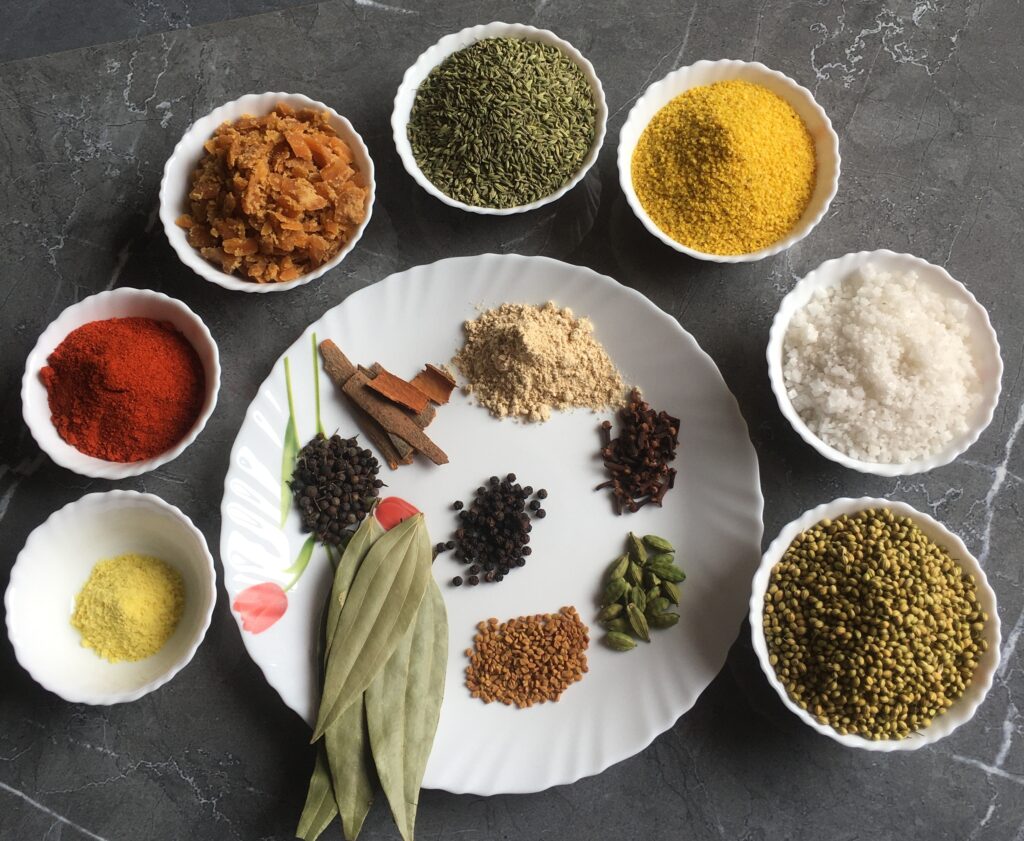
Ingredients
- Kairi (Raw Green Mangoes) – 5 Kg.
- Gud (Jaggery) – 2 and 1/2 Kg.
- Oil – 2 Kg.
- Salt – 1/4 kg + 1/4 Kg.
- Dhana (Coriander Seeds) – 125 gm.
- Saunf (Fennel Seeds) – 125 gm.
- Mohari Dal (Split Mustard Seeds) – 125 gm.
- Red Chili Powder – 50 gm.
- Hing (Asafoetida) – 10 gm.
- Dalchini (Cinnamon Stick) – 10gm.
- Sunth (Dry Ginger Powder) – 10 gm.
- Methi Dana (Fenugreek Seeds) – 5 gm.
- Veldoda (Cardamom Pods) – 5gm.
- Laung (Cloves) – 5 gm.
- Kapoor Chini – 5 gm.
- Mire (Black Pepper Seeds) – 5 gm.
- Tejpan (Cinnamon Leaves / Bay Leaf) – 5 leaves.
Step by Step Raw Green Mango Pickle Recipe
1. How to Select Best Quality Green Mangoes?
Select correct variety raw mangoes. Choose the karies which are explicitly raw, green and firm. Hand pick one kairy check for color and firmness. Though it is time consuming, it is essential. It is worth doing it as you are going to do it only once a year. Avoid taking raw mangoes which are loose or has any kind of cuts on it. Also check for which variety of kairy to choose?. Now a days many varieties are available in the market. If you prefer sour pickle then go for organic variety. It is easy to identify organic version, just check for size and color. Specifically, smaller size kairy is sour in taste. Kesar and totapuri karies are not much sour in taste. So these kind of kairies are preferred for making methamba and gulamba.

2. Wash Karies Properly
Wash all karies properly with lots of water so as to remove all dirt and sticky sap from the outside skin. Do not use any chemical since washing with lots of cold water is enough. If the sap is hard to remove then just soak karies in water for few hours. Finally, pat dry with clean towel.

3. Cut Raw Mangoes into Pieces.
Firstly cut karies into small pieces. But this is not a easy job. It is hard to do it at home with normal knife. You need a special cutter to cut raw mangoes because seed inside the kairy is too hard to cut. You can also do it at home with axe or iron cutter. Usually when you are buying karies from local market, vendor itself has big cutter and helps to cut raw mangoes. When he is cutting karies, make sure that he will make very small pieces because big pieces are hard to handle.

4. Spread the Pieces
Spread the pieces on clean cotton sheet. Also take out seed particles, if any. If you find any dirt on pieces then simply wipe it with clean towel. Avoid washing raw mango pieces because wet pieces can spoil the pickle. Let these raw mango pieces stay in shadow till dry a bit.

5. Add Salt and Turmeric
Add salt, turmeric and 1/4 kg salt. If you want more salty, then you may add more salt or even reduce the salt quantity as per your choice. 1/2 kg salt is enough for normal salty flavor. I used crystal salt here because this salt does not contain any chemical and additive. Also use adequate amount of turmeric, which will coat all pieces. Mix salt, turmeric and raw mango pieces properly. Keep this mixture over night or for 12 hours. Try to use stainless steel, clay pot, earthen pot, glassware or chini mitti pots while preparing pickle. Avoid using aluminum and iron pots, while preparing pickle as sour ingredients could react with it.
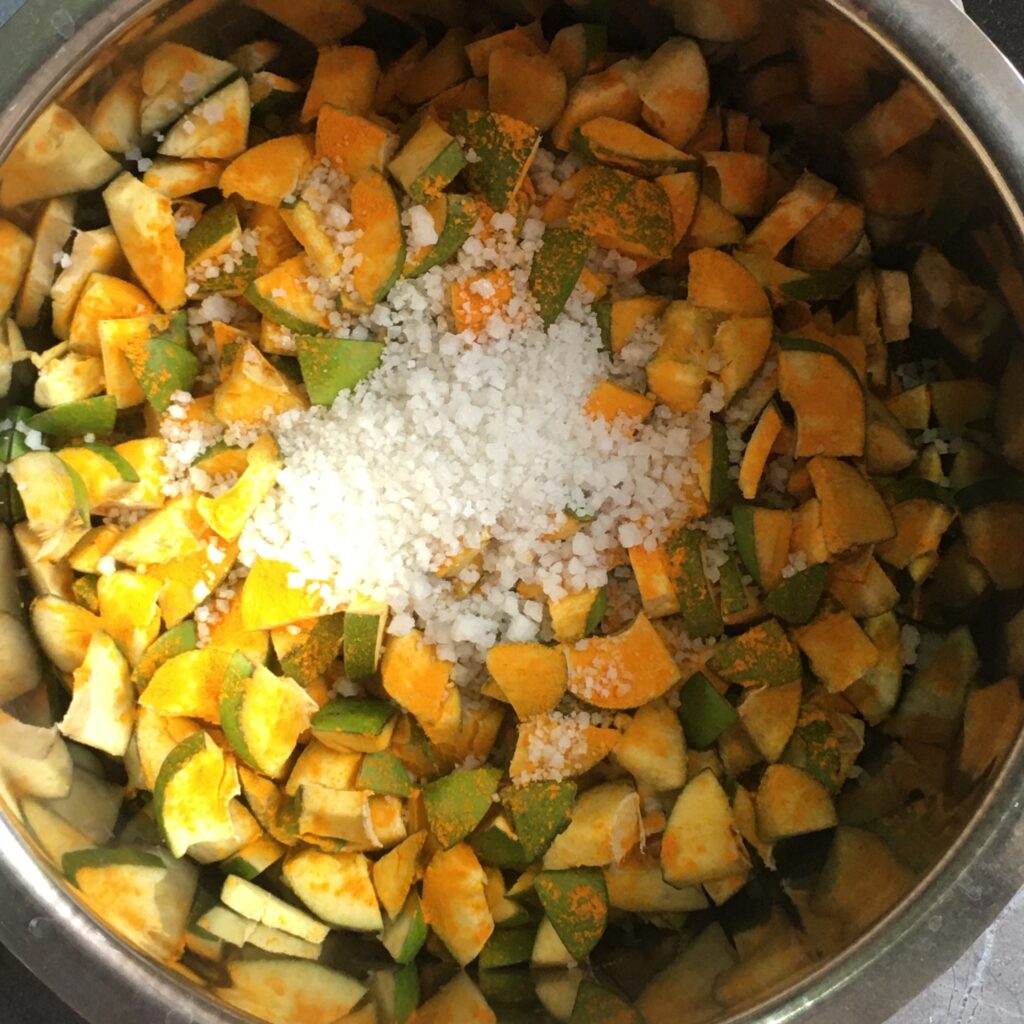
6. Homemade Pickle Masala Powder
While salt, turmeric and mango pieces mixture is setting, we can prepare pickle masala. Measure all spices mentioned in the above ingredient list. Add Coriander seeds, fennel seeds, cinnamon sticks, dalchini, cardamom pods, cloves, kapoor chini, black pepper seeds, bay leaves in mixer grinder. Make coarse powder. Take out this powder is bowl. Add dry ginger powder, red chili powder, split mustard seeds and asafoetida powder in it. Dry powder for authentic pickle masala is ready.
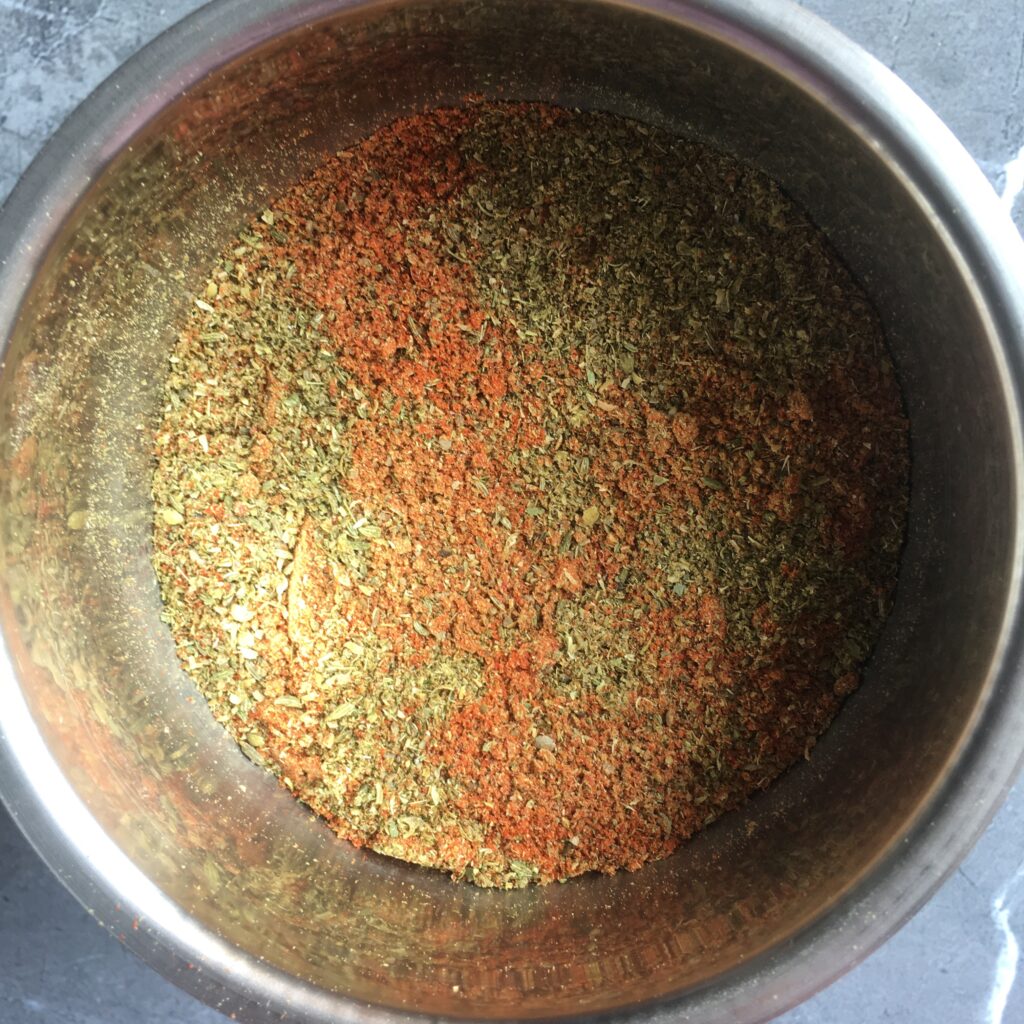
7. Mix Dry Masala Powder with Oil
In thick bottom pot, heat 2 kg. oil. You may use any oil, I used cold pressed sunflower oil. Heat the oil till its very hot, start leaving cooking smell. Do not over heat because it could burn. Remove from heat, and wait for 10 minutes, so that it will be cool a bit. Add fenugreek seeds in it, wait until seeds turn little brown. Wait again for 5 minutes. Add grinded masala made previously in step 6 to this oil. Before adding masala make sure oil is not very hot, as it could burn masala ingredients. It should not be very cold as these ingredients should get fried nicely. Finally, stir well and keep it aside to cool down.

It may take 4-5 hours for this mixture to completely cool down.
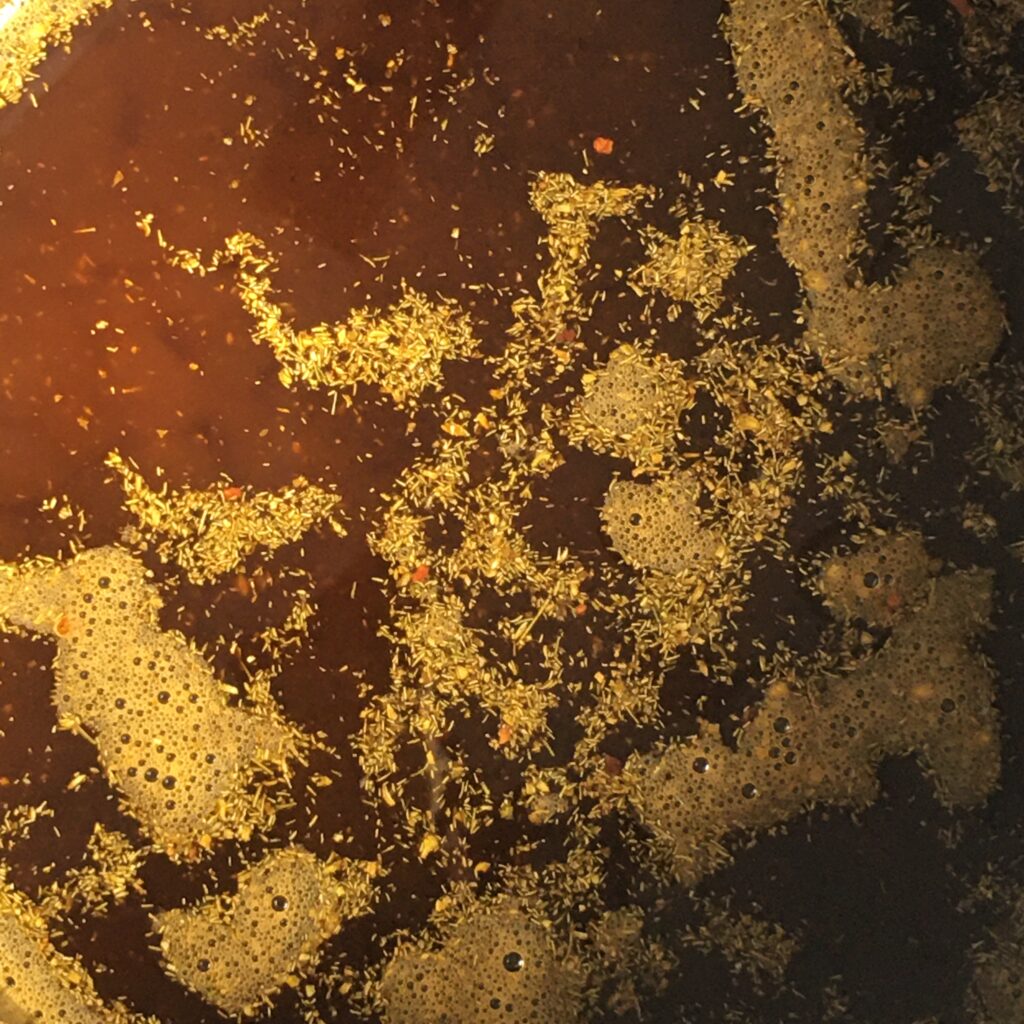
8. After 12 Hours

Next day morning or after 12 hours, you will some water at the bottom of the pot. Now what to do with this water? Some recipes suggest to discard this water. But some recipes suggest to keep this juice as it is. This juice is highly acidic nature, sour in taste and act as preservative for pickle. This is totally up to you if you want to use it or not. I an going to keep this water as it is, as I prefer sour pickle.
9. Add Jaggery
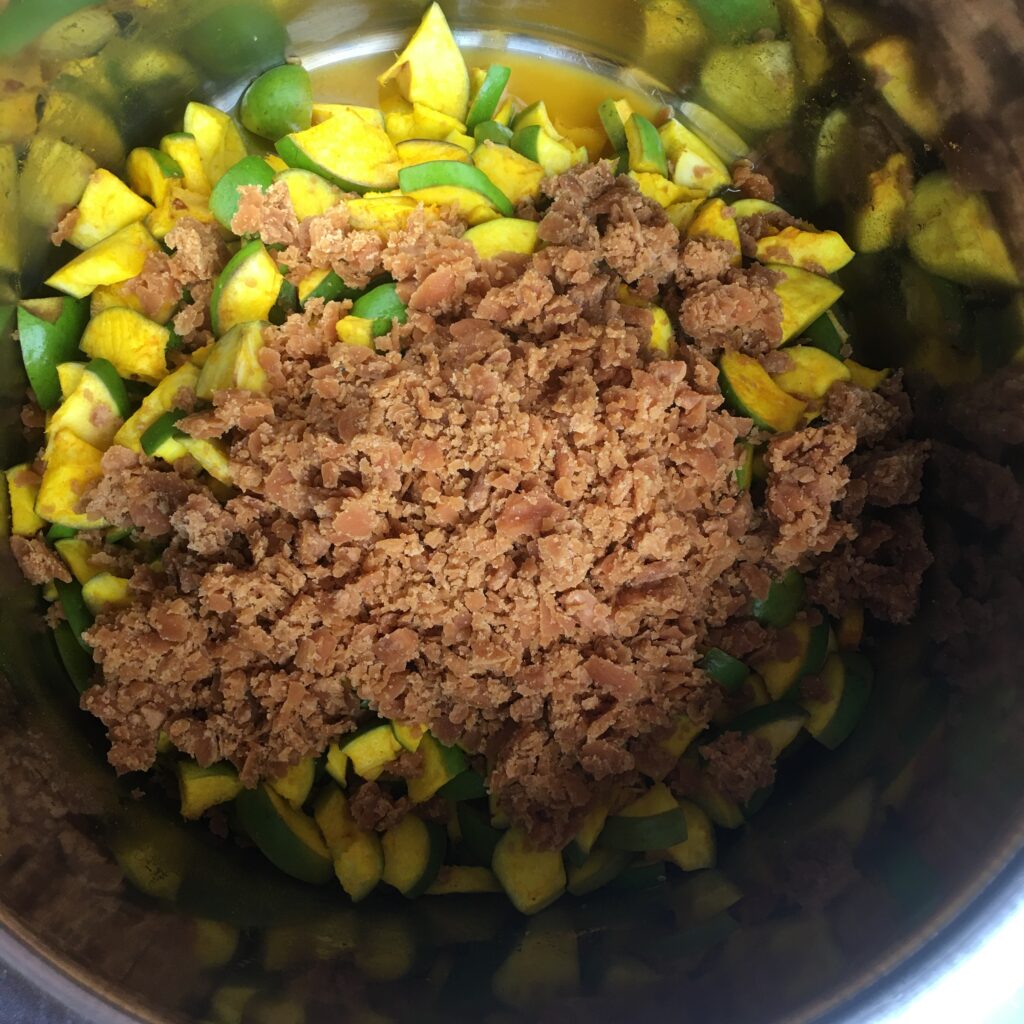
Crush jaggery into small pieces. You may also grate with grater or knife. Add jaggery over mango pieces. Here, I used 2 and 1/2 kg jaggery. If you want more sweeter version then add 3 kg jaggery. If you want less sweet then you may reduce jaggery quantity. 1 kg. jaggery will yield into milder sweet pickle. You can skip adding jaggery if you want sour and spicy mango pickle. After adding jaggery, let the mixture settle for more 2-3 hours, to get jaggery melt completely. Mix well and stir in between. Do not rush to add other ingredients, as oil could slow down jaggery melting procedure. Once jaggery is completely melted, mixture will look something like this.
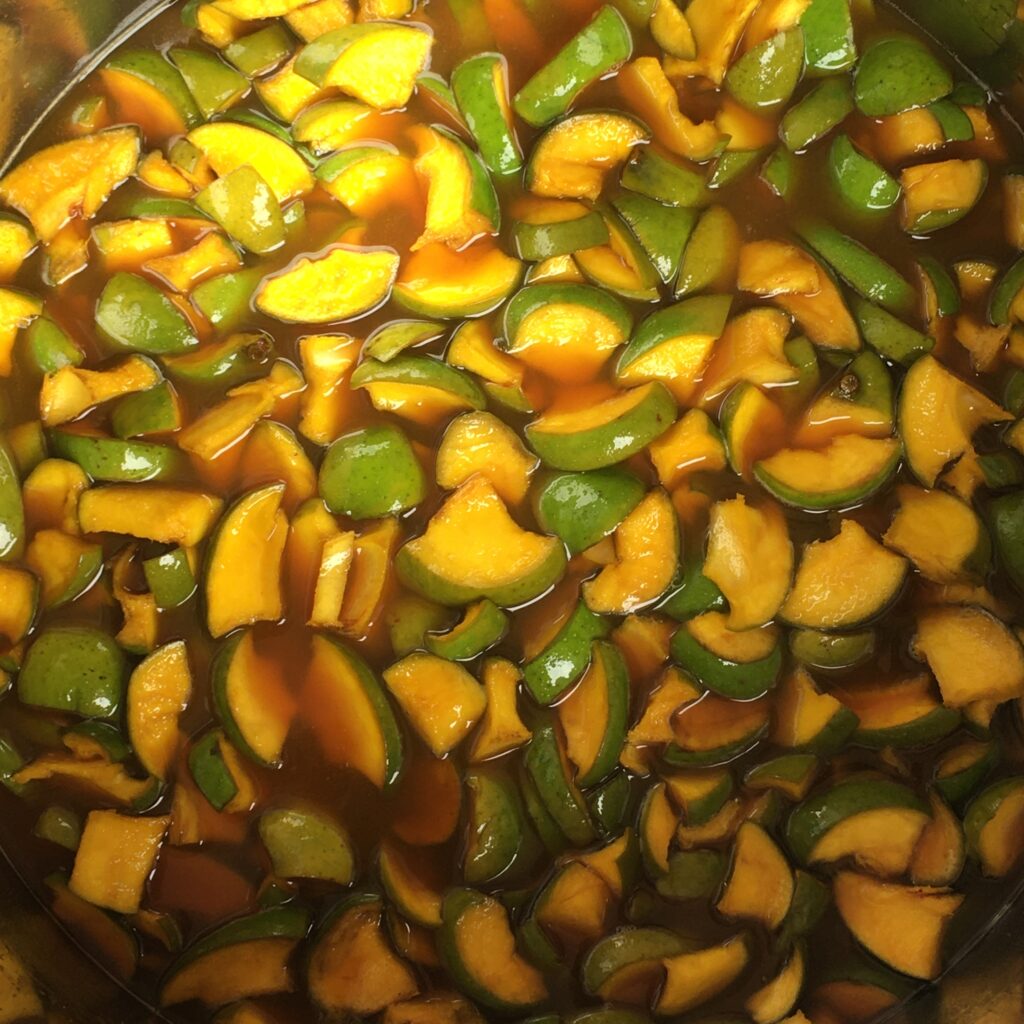
10. Homemade Masala + Kairy Pieces = Sweet Green Mango Pickle
Pour oil masala mixture on raw mango pieces.

Finally, mix well and fill into air tight glassware. And tasty raw mango pickle / achaar will be ready after 15 days.

Instant Easy Homemade Raw Mango Pickle Recipe
It an easy-to-follow recipe for a delicious authentic homemade raw mango pickle. It includes step-by-step instructions for prepping and cooking the pickle, as well as tips for storing it for maximum freshness and flavor. We have also discussed the health benefits of eating raw mango pickles and provided advice on how to get the most out of your pickle. Finally, we have shared some creative ways to use your pickle in recipes and as an accompaniment to meals.
- Ingredients
- 2 large raw mangoes, washed, peeled and cut into cubes
- 1 teaspoon mustard seeds
- 2 teaspoons fenugreek seeds
- 2 tablespoons sesame oil
- 2 tablespoons red chilli powder
- 2 tablespoons salt
- 2 tablespoons sugar
- 2 tablespoons turmeric powder
- 2 tablespoons coriander powder
- 2 tablespoons ground ginger
- 2 tablespoons ground garlic
- 1 teaspoon asafoetida (hing)
- 2 tablespoons white vinegar
- 1 teaspoon black mustard seeds
- Instructions
- In a large bowl, mix together the cubed raw mangoes, mustard seeds, fenugreek seeds, sesame oil, red chilli powder, salt, sugar, turmeric powder, coriander powder, ginger, garlic, asafoetida, white vinegar and black mustard seeds.
- Mix until all ingredients are well combined.
- Transfer the mixture to a clean glass jar and seal tightly.
- Place the jar in a cool, dark place for at least 2 weeks to allow the flavors to develop.
- Shake the jar every few days to ensure the ingredients are mixed well.
- After 2 weeks, the pickle will be ready to enjoy. Store in the refrigerator for up to 3 months.
Raw Mango Pickle Health Benefits
- Rich in Nutrients: Raw mango pickle is a rich source of various essential vitamins, minerals and other nutrients. It is a rich source of Vitamin A, Vitamin C, iron, calcium, magnesium, phosphorus and potassium.
- Digestive Benefits: Raw mango pickle helps to improve digestion, as it contains enzymes that help to break down complex carbohydrates and proteins. This helps to keep the digestive system healthy and functioning properly.
- Immunity Booster: The high levels of Vitamin C in raw mango pickles helps to boost the immune system and helps to protect the body from various harmful bacteria and viruses.
- Prevents Anemia: Raw mango pickles are rich in iron, which helps to prevent anemia, a condition caused by a lack of red blood cells in the body.
- Skin Health: The antioxidants present in raw mango pickles help to protect the skin from damage caused by free radicals and helps to keep it looking young and healthy.
Indian kitchen is incomplete without achaar. It goes well with paratha, snacks, thepalas, and rice. Though it is sour in taste, pickle never irritates throat as that of other sour food items. Most ladies think that it is very tedious job to make pickle. Here we are giving you an authentic India raw mango pickle recipes with homemade masala. Also we are giving you tips which will make your pickle safe for 2-3 years, without any fungus. These tips and tricks which will prevent pickle to get spoiled.
FAQs.
Q. Which mango is best for pickle?
Raw Alphonso or Ratnagiri variety of the mango is best for pickle, as they have a sweeter flavor and a higher oil content.
Q. How to avoid pickle from spoiling?
Ingredients such as vinegar, salt, sugar, and spices are commonly used as preservatives for pickle. These ingredients create an acidic environment that is inhospitable to bacteria and mold, which helps to prevent spoilage. Additionally, the addition of herbs and spices can help to enhance the flavor of the pickles.
- Take fresh and firm mangoes. Avoid soft mangoes and discard mangoes which you see ripened after cutting.
- Tightly seal the pickles in an airtight container. This will help prevent the pickles from being exposed to air and moisture, which can cause spoilage.
- Make sure to use a clean spoon each time when you take out the pickles from the container in order to prevent cross contamination.
- Avoid storing pickles in direct sunlight and in areas where the temperature is too high. This will help prevent the pickles from spoiling quickly.
- Oil should make at least 1 inch layer over mango pickles. No mango pieces should be out of oil, as it could spoil the pickle with fungus. Oil plays an important role in the preservation of pickles. It helps to seal off the pickles from the air and prevent oxidation, which can cause off-flavors and spoilage. Additionally, oil helps to keep the spices and seasonings on the pickles and prevents them from washing away when the pickle is submerged in a vinegar solution.
- Use appropriate amount of salt as, salt works as preservative in pickle. For 5kg. of mango pieces use 1 kg. of salt. Use plain salt, crystal salt is the best. Salt is one of the most important ingredients in pickling. It helps to preserve the food and prevents spoilage by drawing out moisture and creating an environment that is inhospitable to bacteria and other microorganisms. Salt also helps to extract flavor from the food and gives pickles their characteristic salty taste.
- All utensils that you are using should be clean and dry. It is best to use glass, ceramic, or chini mitti pots for making and storing pickles. These materials do not react with vinegar or salt, which are both necessary for pickling. In addition, these materials are non-porous and easy to clean, which helps keep your pickles free of bacteria and mold.
Q. How do I keep my mango pickle fresh for a long time without adding any preservatives?
To keep your mango pickle fresh for a long time without adding preservatives, you should store it in an airtight container in the refrigerator. Make sure to keep the container clean and dry and to use a clean spoon when taking out the pickle. Additionally, you should also use pickle that are ripe but still firm, and you should use them within a few weeks. You can also try adding some vinegar, oil, and spices to the pickle to help preserve it.
Q. Is eating mango pickle safe for GERD patients?
Eating mango pickle is not generally recommended for GERD patients. The spices and vinegar in the pickle can aggravate GERD symptoms. Eating mangoes in moderation may be okay, but it’s best to consult with your doctor before consuming any foods that may trigger GERD symptoms.
Q. How do I use the leftover oil from a mango pickle?
Leftover oil from mango pickle can be used in a variety of dishes to add flavor and depth. It is great for sautéing vegetables, adding to marinades or sauces, or even used as a salad dressing. You could also use it to fry eggs or tofu for a unique flavor. Additionally, you could use the oil to make a spicy Indian-style curry.
Q. What’s the difference between a mango pickle and a mango chutney?
Mango pickle is a spicy condiment made from raw mangoes, while mango chutney is a sweet and tangy condiment made from cooked or ripe mangoes. Mango pickle typically has a longer shelf life than mango chutney. Additionally, mango pickle is usually served as a side dish, while mango chutney is usually used as a condiment or dip.
Q. What is the origin, growth and history of pickles specially mango pickle?
Pickles have been around for centuries, and have been a staple in many cultures for just as long. Mango pickle have been popular in India since at least the 1500s, with references to mango pickle found in ancient texts. Mango pickles were likely brought to India from Southeast Asia, where pickling was already popular. In India, mango pickle is made using a combination of oil, spices, and salt. The mangoes are soaked in salted water for a few days, then mixed with a combination of spices, such as fenugreek, mustard, turmeric, chili powder, asafoetida, and curry leaves. The mixture is then left to ferment for a few days before it is ready to be eaten. Today, raw mango pickle is still a popular condiment in India, as well as in many other parts of the world. They are available in a variety of flavors, ranging from sweet and sour to spicy and tangy. They are also a popular accompaniment to a variety of dishes, such as curries, biryani, and rice. Pickled mangoes are also used to add a sweet and tangy flavor to salads and appetizers.
Q. What are some popular South Indian pickles?
Pickles are an integral part of South Indian cuisine and are often served as a condiment with meals. Pickles are believed to aid digestion and provide essential vitamins and minerals. They are also a great way to add flavor and texture to a dish. Pickles are also popularly served as accompaniments to rice and other dishes.
- Avakaya (Mango Pickle)
- Gongura (Sorrel Leaves Pickle)
- Narthangai (Citron Pickle)
- Vadu Mangai (Garlic Pickle)
- Uppu Manga (Salt & Mango Pickle)
- Puli Inji (Tamarind & Ginger Pickle)
- Maavadu (Small Fish Pickle)
- Thokku (Vegetable Pickle)
- Thokkudu (Grated Coconut Pickle)
- Nellikai (Gooseberry Pickle)
Q. Why do we eat pickles with our meal? Is this habit good for our health?
Pickles are a great way to add flavor and crunch to a meal. They can also help to contribute towards a balanced diet, as they are low in calories and fat and contain some essential vitamins and minerals. Pickles are also high in probiotics, which can help support digestive health. So, overall, eating pickles with your meal can be a healthy habit.
Q. What is the difference between fruit preserves and pickles?
Fruit preserves are made from whole or chopped fruits that have been cooked in sugar syrup until they reach a thick, jam-like consistency. Pickles, on the other hand, are made from cucumbers or other vegetables that have been pickled in a vinegar or brine solution.
Q. What are the main ingredients used in Punjabi pickles?
The main ingredients used in Punjabi pickles are oil, mustard seeds, fenugreek, red chilli powder, turmeric, salt, garlic, asafoetida, and a variety of spices.
